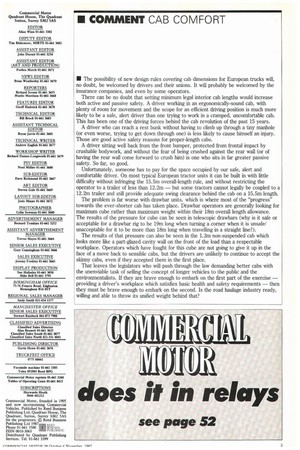• COMMENT CAB COMFORT
Page 5

If you've noticed an error in this article please click here to report it so we can fix it.
• The possibility of new design rules covering cab dimensions for European trucks will, no doubt, be welcomed by drivers and their unions. It will probably be welcomed by the insurance companies, and even by some operators.
There can be no doubt that setting minimum legal interior cab lengths would increase both active and passive safety. A driver working in an ergonomically-sound cab, with plenty of room for movement and the scope for an efficient driving position is much more likely to be a safe, alert driver than one trying to work in a cramped, uncomfortable cab. This has been one of the driving forces behind the cab revolution of the past 15 years.
A driver who can reach a rest bunk without having to climb up through a tiny manhole (or even worse, trying to get down through one) is less likely to cause himself an injury. Those are good active safety reasons for proper-length cabs.
A driver sitting well back from the front bumper, protected from frontal impact by crushable bodywork, and without the fear of being crushed against the rear wall (or of having the rear wall come forward to crush him) is one who sits in far greater passive safety. So far, so good.
Unfortunately, someone has to pay for the space occupied by our safe, alert and comfortable driver. On most typical European tractor units it can be built in with little difficulty without infringing the 15.5m overall-length rule, and without restricting the operator to a trailer of less than 12.2m — but some tractors cannot legally be coupled to a 12.2m trailer and still provide adequate swing clearance behind the cab on a 15.5m length.
The problem is far worse with drawbar units, which is where most of the "progress" towards the ever-shorter cab has taken place. Drawbar operators are generally looking for maximum cube rather than maximum weight within their 18m overall length allowance. The results of the pressure for cube can be seen in telescopic drawbars (why is it safe or acceptable for a drawbar rig to be 19m long when turning a corner when it is unsafe/ unacceptable for it to be more than 18m long when travelling in a straight line?).
The results of that pressure can also be seen in the 1.3m non-suspended cab which looks more like a part-glazed cavity wall on the front of the load than a respectable workplace. Operators which have fought for this cube are not going to give it up in the face of a move back to sensible cabs, but the drivers are unlikely to continue to accept the skinny cabs, even if they accepted them in the first place.
That leaves the legislators who will push through the law demanding better cabs with the unenviable task of selling the concept of longer vehicles to the public and the environmentalists. If they are brave enough to embark on the first part of the exercise — providing a driver's workplace which satisfies basic health and safety requirements — then they must be brave enough to embark on the second. Is the road haulage industry ready, willing and able to throw its unified weight behind that?




































































































